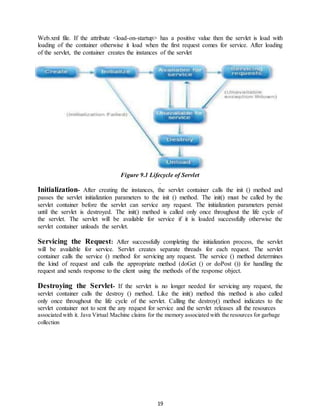This document is a summer training report submitted by Nitesh Saini to fulfill the requirements for a Bachelor of Technology degree in Computer Science Engineering. The report details Nitesh's training at Technoglobe Organization of VSM InfoTech, where he learned about advance Java topics including object oriented programming and software engineering. As part of a student project, Nitesh helped develop a text editor application and was introduced to concepts like servlets, applets, and electronic services. The successful project recommended using XML instead of HTML for improved structure.







![viii
INDEX
CHAPTER 1 TECHNOLOGY………………………….….… [1]
CHAPTER 2 COLLECTION………………………...…... [2 -3]
CHAPTER 3 MULTITHREADING…………………… …... [4-5]
CHAPTER 4 JAVA NETWORKING……...……………….... [6]
CHAPTER 5 AWT……………………………………………..... [7]
CHAPTER 6 SWING…………………………………………… [8]
CHAPTER 7 JAVA DATABASE CONNECTIVITY….... [9-11]
CHAPTER 8 JAVA SERVER PAGE…..…………………… [12-16]
CHAPTER 9 JAVA SERVER PAGE…..…………………… [17 - 18]
CHAPTER 10 APPLET………………...…………………….. [19 - 20]
CHAPTER 11 PROJECT………………...…………………….. [21 - 23]
CONCLUSION](https://image.slidesharecdn.com/niteshfinal-171209211301/85/Advance-java-summer-training-report-8-320.jpg)












![13
CHAPTER – 8
JAVA SERVER PAGES
Java Server Pages (JSP) is a technology that helps software developers create dynamically
generated web pages based on HTML, XML, or other document types. Released in 1999 by Sun
Microsystems [1], JSP is similar to PHP, but it uses the Java programming language. To deploy
and run Java Server Pages, a compatible web server with a servlet container, such as Apache
Tomcat or Jetty, is required.
Java Server Pages is a technology which permits software developers to create dynamic request
like HTML, XML in order to answer to client request in the net. This technology lets Java code
and definite pre-defined procedures to be implanted into static content. The syntax in Java Server
Pages includes a supplementary XML tag which is known as JSP actions.
It is made use to evoke the utility of the built-in functions. Moreover JSP permits to establish and
form the JSP tag libraries which operate as an extension to the standard XML or HTML tags.
These JSP tag libraries give a good technique to widen the potentiality of the Web server by
providing an independent platform’s compiler compiles the JSPs into Java Servlets
Figure 8.1 JSP
A JSP compiler may possibly create a servlet in Java code and it is later compiled by the Java
compiler. It might even directly produce the byte code for the servlet. Java Server Pages can be
examined as a high level abstraction of servlets which is practiced as an extension of the
Servlet2.1API.
Java Server Pages are HTML pages embedded with snippets of Java code. It is an inverse of a
Java Servlet
JSPs run in two phases
Translation Phase- In translation phase JSP page is compiled into a servlet called JSP Page
Implementation class
Execution Phase- In execution phase the compiled JSP is processed](https://image.slidesharecdn.com/niteshfinal-171209211301/85/Advance-java-summer-training-report-21-320.jpg)









![23
Registrationofa user:-
To become a valid user all the user have to register on the system so they have their individual
identity in the system. So every user have different entity.
Fig 11.2. registration page
Login to Account:-
A login, logging in or logging on is the entering of identifier information into a system by a user
in order to access that system (e.g., a computer or a website). It is an integral part of computer
security procedures.
]To access all the banking rights user have to logged in the system so that he/she can use all the
right provided by the bank.
Fig.11.3 Login page](https://image.slidesharecdn.com/niteshfinal-171209211301/85/Advance-java-summer-training-report-31-320.jpg)

